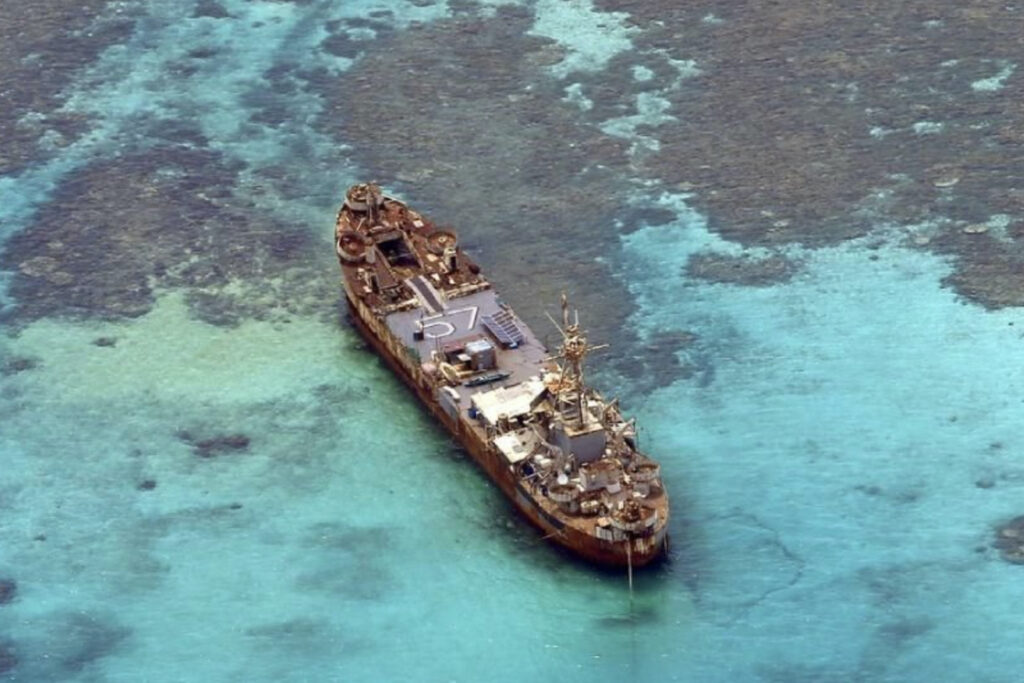As the war between Israel and Hamas enters a month half a world away, another conflict is brewing, this one around a tiny atoll and a decaying World War II-era landing ship. On October 22, 2023, four Chinese Coast Guard vessels supported by an additional five vessels from the People’s Maritime Militia attempted to block the delivery of supplies by two specially chartered supply boats to the BRP Sierra Madre, a Philippine ship permanently moored in Second Thomas shoal as part of an ongoing effort by the Philippines to assert sovereignty over the area. The resulting standoff drew in two Philippine patrol vessels, which resulted in dangerous posturing and maneuvering and a collision. There was also a reported incident between a Filipino Coast Guard vessel and a Chinese fishing vessel, which resulted in a minor collision on the same day.
While there were no injuries in either incident, the Chinese and Philippine Coast Guards blamed each other for causing the collision and issued formal diplomatic protests to the other’s governments. According to CNN, the Filipino government considered China’s move as provocative, illegal, and dangerous, as well as infringing on the sovereign territory of the Philippines. China contends that Filipino vessels illegally entered Chinese territorial waters, that the Chinese Coast Guard was acting per international law when they intercepted the Filipino vessel, and that it was Filipino actions that caused the accident.
The second Thomas Shoal is a tiny atoll, little more than a coral reef and sandbank, which lies in the South China Sea as part of the Spratly Island chain and has been a disputed territory between the People’s Republic of China and the Philippines since the 1990s. This conflict is part of a border struggle between China and its maritime neighbors in Vietnam, the Philippines, and Taiwan over their territorial limits and exclusive economic zones. According to the UN Convention on the Law of the Sea (UNCLOS), a country can claim up to 12 miles as the territorial limit in which it has exclusive legal and economic jurisdiction and an economic exclusion zone in which it can expand up to 200 miles in which they have exclusive rights to exploit economically any resources within such as fishbeds and oil deposits. However, they cannot enforce their laws on ships flagged by other countries that only pass through the territory under the right of innocent passage. China contends that the entire South China Sea, first the nine and later revised to the twelve-dash line, is their rightful territorial limit, including all islands and territories. China’s claims have repeatedly failed in international courts and arbitration, with the Second Thomas Shoals being formally awarded to the Philippines in a 2016 legal decision by an arbitration panel empowered under UNCLOS.
The importance of the Second Thomas Shoal, specifically, and the South China Sea in general, is that it is a huge economic artery through which most of the world’s trade between East Asia, Europe, Africa, and North America flows. Additionally, it is home to rich fishing grounds that provide a large portion of the region’s seafood and economic livelihood for thousands of Chinese, Vietnamese, Filipino, Indonesian, and Malaysian fishermen. It is also home to one of the world’s largest untapped oil and natural gas reserves, with an estimated 11 Billion barrels of untapped oil and 190 trillion cubic feet of natural gas, according to CNN. This gives Beijing a huge economic incentive to gain control of the region to fuel its economy and strengthen its global position. This has resulted in China beginning a program of fortifying islands and building up its Navy to be the largest by number of ships in the world, according to a report by the USNI. Other countries in the region have done the same, with the Philippines grounding the BRP Sierra Madre permanently in the Second Thomas Shoal and installing a garrison of marines on board in order to enforce their maritime claims as early as 1999.
The international response to the latest heightening of tensions in the South China Sea has been largely muted, with global focus remaining on the ongoing conflicts in Ukraine and Israel. Still, the U.S. did commit to defending the Philippines and its territorial claims and upholding the principle of freedom of Navigation. The U.S.S. Ronald Reagan visited the Philippines and Manila on October 30th as part of a goodwill tour and show of force, while the U.S. Coast Guard committed to supporting their colleagues in the Philippine Coast Guard.
With the Chinese navy set to grow even larger over the coming years, there is no doubt that they will continue to get progressively more aggressive in asserting their maritime sovereignty and territorial claims in South China. Without careful management by diplomats, politicians, and military officials, this hot spot could boil over into a full-fledged regional conflict with untold impacts on the global economy and the lives of everyday people.

